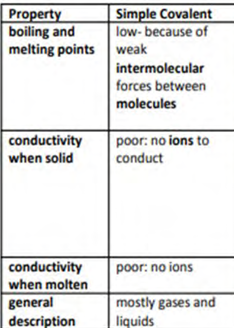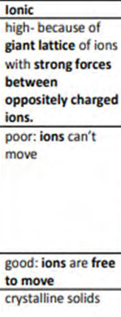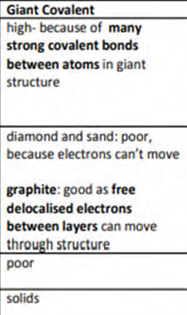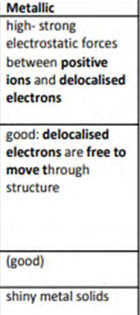chemistry bonds
1/33
There's no tags or description
Looks like no tags are added yet.
Name | Mastery | Learn | Test | Matching | Spaced |
|---|
No study sessions yet.
34 Terms
What is ionic bonding?
Ionic bonding is the electrostatic attraction between positive and negative ions. It is a relatively strong attraction.
How are ionic compounds held together?
● They are held together in a giant lattice.
● It’s a regular structure that extends in all directions in a substance.
● Electrostatic attraction between positive and negative ions holds the structure together
State properties of ionic substances
● High melting and boiling point (strong electrostatic forces between oppositely charged ions)
● Do not conduct electricity when solid (ions in fixed positions).
● Conduct when molten or dissolved in water - ions are free to move.
Give 5 examples of positive ions and 5 examples of negative ions (give names of negative anions). What is important when working out a formula of an ionic compound?
E.g. Positive: Na+, Mg2+, Al3+, Ca2+, Rb+, E.g.
Negative: Cl−, Br−, SO4 2−, NO3 −, OH− (chloride, bromide, sulfate, nitrate, hydroxide).
Ionic compounds are electrically neutral, i.e. positive and negative charges balance each other
How are ionic compounds formed? Explain in terms of MgO case.
Reaction of a metal with a non-metal
. Electron transfer occurs - metal gives away its outer shell electrons to non-metal.
Mg is in Group II, so has 2 available outer shell electrons
. O is in Group VI, so can accept 2 electrons to get a full outer shell configuration
. Mg becomes Mg2+ and O becomes O2− (oxide).
What is a covalent bond?
Covalent bond is a shared pair of electrons between two atoms
Describe the structure and properties of simple molecular covalent substances
- Do not conduct electricity (no ions)
- Small molecules
- Weak intermolecular forces, therefore:
- Low melting and boiling points
How do intermolecular forces change as the mass/size of the molecule increases?
They increase. That causes melting/boiling points to increase as well (more energy needed to overcome these forces)
As the mass or size of the molecule increases, intermolecular forces become stronger, resulting in higher melting and boiling points due to the greater energy required to overcome these forces.
What are polymers? What are thermosoftening polymers?
Polymers are very large molecules (>100s, 1000s of atoms) with atoms linked by covalent bonds.
Thermosoftening polymers - special type of polymers; they melt/soften when heated. There are no bonds between polymer chains. Weak intermolecular forces ensure that the structure is solid at room temperature. These forces are overcome with heating - polymer melts.
What are giant covalent substances? Give examples
- Solids, atoms covalently bonded together in a giant lattice.
High melting/boiling points – strong covalent bonds.
Mostly don’t conduct electricity (no delocalised e−) Diamond, graphite, silicon dioxide
Describe and explain the properties of allotropes of carbon. Diamond
– four, strong covalent bonds for each carbon atom
– very hard (Strong bonds)
– very high melting point (strong bonds)
– does not conduct (no delocalised electrons)
Describe and explain the properties of allotropes of carbon. Graphite
– three covalent bonds for each carbon atom
– layers of hexagonal rings
– high melting point
– layers free to slide as weak intermolecular forces between layers; soft, can be used as a lubricant
– conduct thermal and electricity due to one delocalised electron per each carbon atom
Describe and explain the properties of allotropes of carbon Fullerenes
– hollow shaped molecules
– based on hexagonal rings but may have 5/7-carbon rings
– C60 has spherical shape, simple molecular structure (Buckminsterfullerene)
Describe and explain the properties of allotropes of carbon. Nanotubes
– cylindrical carbon structures
– made up of hexagonal and pentagonal rings
– excellent strength-to-weight ratio, used in various applications
– good conductors of electricity and heat due to delocalised electrons
– cylindrical fullerene with high length to diameter ratio
- High tensile strength (strong bonds)
Graphene - a single layer of graphite.
What is metallic bonding?
Forces of attraction between delocalised electrons and nuclei of metal ions.
Describe properties of metals
--- High melting/boiling points (strong forces of attraction)
Good conductors of heat and electricity (delocalised electrons)
Malleable, soft (layers of atoms can slide over each other whilst maintaining the attraction forces)
What are alloys? Why are they harder than pure metals?
Alloys:- mixtures of metal with other elements, usually metals- different sizes of atoms distorts the layers, so they can’t slide over each other, therefore alloys are harder than pure metals
mixtures of metals with other elements, creating a solid solution. The different sizes of atoms distort the metallic lattice, preventing the layers from sliding easily, making alloys harder than pure metals.
describe the properties for simple covalent bonds, for boiling and melting points, conductivity when solid, conductivity when molten, and general description

describe the properties for simple ionic bonds, for boiling and melting points, conductivity when solid, conductivity when molten, and general description
Simple ionic bonds are characterized by high melting and boiling points due to strong electrostatic forces between oppositely charged ions. They do not conduct electricity in solid form but conduct when molten or dissolved in water.


describe the properties for giant covalent bonds, for boiling and melting points, conductivity when solid, conductivity when molten, and general description

describe the properties for metallic bonds, for boiling and melting points, conductivity when solid, conductivity when molten, and general description
Metallic bonds exhibit high melting and boiling points due to strong attraction between metal ions and delocalized electrons. They conduct electricity in both solid and molten states because of the mobility of these electrons.

What are the limitations of the simple model?
There are no forces between spheres and atoms, molecules and ions are solid spheres – this is not true
What does the amount of energy needed to change state from solid to liquid or liquid to gas depend on?
The strength of the forces between the particles of the substance. The nature of the particles involved depends on the type of bonding and the structure of the substance. The stronger the forces between the particles the higher the melting point and boiling point of the substance
A pure substance will melt or boil at…?
A fixed temperature. A mixture will melt over a range of temperatures
What are the three states of matter?
Solid, liquid and gas
What is nanoscience?
Science that studies particles that are 1 - 100nm in size
State the uses of nanoparticles
- Medicine (drug delivery systems) - Electronics - Deodorants - Sun creams (better skin coverage and more effective protection against cell damage)
What are fine and coarse particles?
- Fine particles (soot), 100-2500 nm diameter
- Coarse particles (dust), 2500-105 nm diameter
Why do nanoparticles have properties different from those for the same materials in bulk?
High surface area to volume ratio
diamond
● In diamond (right), each carbon is joined to 4 other carbons covalently. o It’s very hard, has a very high melting point and does not conduct electricity.
Graphite
● In graphite, each carbon is covalently bonded to 3 other carbons, forming layers of hexagonal rings which have no covalent bonds between the layers. o The layers can slide over each other due to no covalent bonds between the layers, but weak intermolecular forces. Meaning that graphite is soft and slippery. ● One electron from each carbon atom is delocalised. o This makes graphite similar to metals, because of its delocalised electrons. o It can conduct electricity – unlike Diamond, because the delocalised electrons can move
Graphene
o Single layer of graphite
o Has properties that make it useful in electronics and composites
o graphene is very strong because atoms within its layers are very tightly bonded and it is also elastic because the planes of atoms can flex relatively easily without the atoms breaking apart.
Carbon can also…
form fullerenes with different numbers of carbon atoms.
o Molecules of carbon atoms with hollow shapes
o They are based on hexagonal rings of carbon atoms, but they may also contain rings with five or seven carbon atoms
o The first fullerene to be discovered was Buckminsterfullerene (C60), which has a spherical shape
Carbon nanotubes and examples of their uses
o Cylindrical fullerenes with very high length to diameter ratios
o Their properties make them useful for nanotechnology, electronics and materials
● Examples of uses
o They can be used as lubricants, to deliver drugs in the body and catalysts.
o Nanotubes can be used for reinforcing materials, for example tennis rackets.